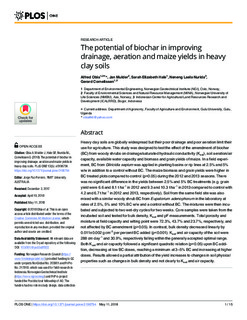| dc.description.abstract | Heavy clay soils are globally widespread but their poor drainage and poor aeration limit their use for agriculture. This study was designed to test the effect of the amendment of biochar (BC) from woody shrubs on drainage/saturated hydraulic conductivity (Ksat), soil aeration/air capacity, available water capacity and biomass and grain yields of maize. In a field experiment, BC from Gliricidia sepium was applied in planting basins or rip lines at 2.5% and 5% w/w in addition to a control without BC. The maize biomass and grain yields were higher in BC treated plots compared to control (p<0.05) during the 2012 and 2013 seasons. There was no significant difference in the yields between 2.5% and 5% BC treatments (e.g. grain yield were 6.6 and 8.1 t ha-1 in 2012 and 9.3 and 10.3 t ha-1 in 2013 compared to control with 4.2 and 6.7 t ha-1 in 2012 and 2013, respectively). Soil from the same field site was also mixed with a similar woody shrub BC from Eupatorium adenophorum in the laboratory at rates of 2.5%, 5% and 10% BC w/w and a control without BC. The mixtures were then incubated and subjected to two wet-dry cycles for two weeks. Core samples were taken from the incubated soil and tested for bulk density, Ksat and pF measurements. Total porosity and moisture at field capacity and wilting point were 72.3%, 43.7% and 23.7%, respectively, and not affected by BC amendment (p>0.05). In contrast, bulk density decreased linearly by 0.011±0.002 g cm-3 per percent BC added (p<0.001). Ksat and air capacity of the soil were 288 cm day-1 and 30.9%, respectively falling within the generally accepted optimal range. Both Ksat and air capacity followed a significant quadratic relation (p<0.05) upon BC addition, decreasing at low BC doses, reaching a minimum at 3–5% BC and increasing at higher doses. Results allowed a partial attribution of the yield increases to changes in soil physical properties such as changes in bulk density and not clearly to Ksat and air capacity. | |
